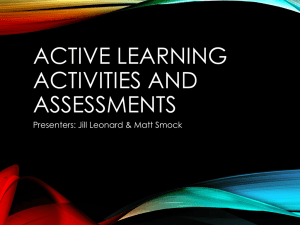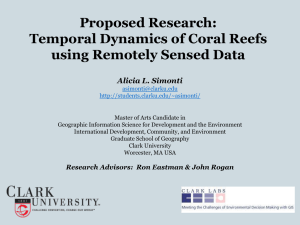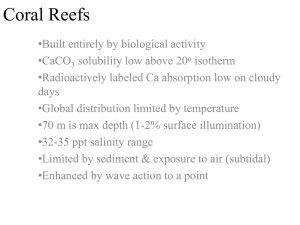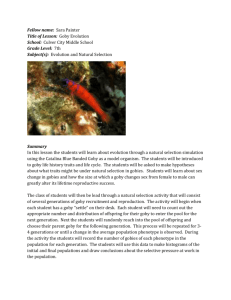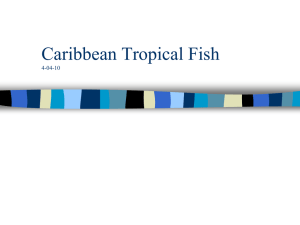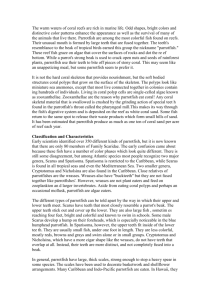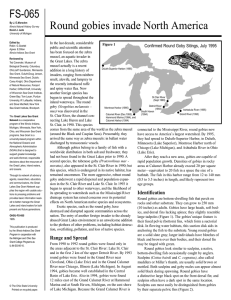2012 Belize Parrotfish research
advertisement
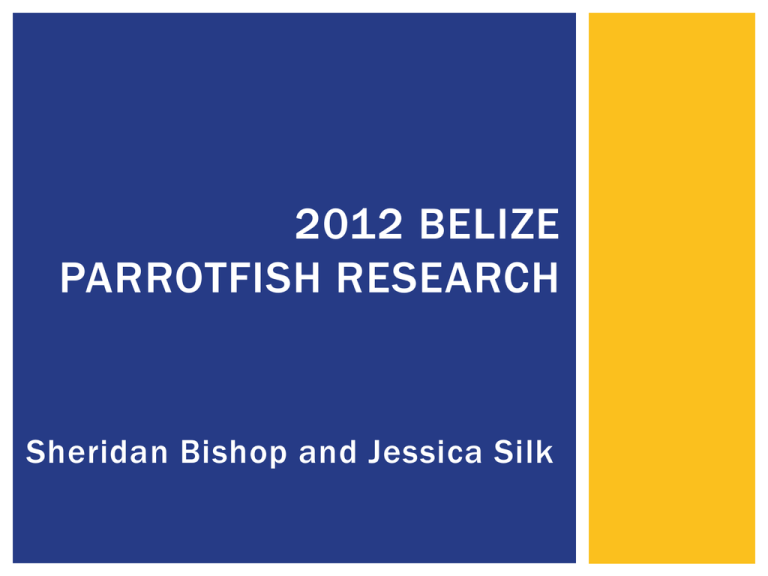
2012 BELIZE PARROTFISH RESEARCH Sheridan Bishop and Jessica Silk WHAT ARE WE INTERESTED IN? Is there a correlation between damaged corals on a reef to the present population of parrotfish? Is the coral experiencing damage from parrotfish? How much? What species is most abundant? WHAT DO WE EXPECT TO FIND? If there is an abundant amount of parrotfish located on a reef, there will be greater damage to stony corals. Damage has been reported frequently on Montastraea annularis (Lobed Star Coral), Montastraea faveolata (Mountainous Star Coral), and Colpophyllia natans (Boulder Brain Coral) Bites are distinct from coral diseases because they remove the skeleton and form abrasions and lesions HOW DO PARROTFISH ENDANGER A REEF? Focused biting is the process where parrotfish repeatedly bite a given area of coral depleting the top layers of the skeleton and living tissue. WHAT PARROTFISH COMMONLY GRAZE? Sparisoma viride (Stoplight) Scarus guacamaia (Rainbow) Scarus Vetula (Queen) HOW WILL WE COLLECT OUR DATA? While conducting our point count we will also be looking at coral for any signs of parrotfish damage. We will record the approximate number of coral affected, measure the length/width/depth, and use our fellow Nauts on fish count surveys to see how many parrotfish were spotted. Correlations Between Fish and Reef Type Connor Waugh Colin Cassick Connor Waugh Colin Cassick Senior 1st Class 7 year veteran Age: 18 Senior at East Lake High School Other interests: Art , Chorus Senior 1st Class 4 year veteran Age: 16 Junior at East Lake High School Other interests: Outdoor activities Question How does reef type effect fish population and diversity? Hypothesis Abundance of fish as well as diversity of species is similar on Patch reefs and Spur and Groove reefs, but is lower on Wall environments. Other Information We chose this topic because we would like to utilize the data we collect during fish counts already conducted on the dives. We suspect that Wall environments will have substantially lower abundance and diversity of fish. While Spur and Groove and Patch reef environments will have a greater number. We hope to learn whether or not there is a difference between diversity and abundance of fish based on reef environments. Questions? Thank You!! Without the support and encouragement of people like you SCUBAnauts would not be as successful as it is today! Belize Science Project 2012 Disease and Bleaching VS. Depth Conner Hutchisson Senior First Class Master Diver 11th Grade- East Lake Brooke Liston Master Naut Master Diver 12th Grade- Palm Harbor Hypothesis: If a coral is located at a shallower depth, it will be more likely to have disease or bleaching. Objectives • Use data collected daily by coral survey groups and collect our own during free time to determine whether there is a correlation between depth and percent of corals with disease or bleaching present. Surveyor: Conner Hutchisson Site Name: Date: Day #: Start Time: 1 AGRRA Code: Yes Site #:1 Subzone/Habitat: o Latitude: o Longitude: Selection Method: Reef Type: Patch Reef Zone: Site Comments: Area Surveyed (m2): 10 Transect Comments: Start Depth: ft/ m End Depth: ft/ m Area Tallied (m2): 10 Abund./Condn. of any MALC, PAL, GOR, SPO, Other: All Corals All Corals All Colonies and Clumps (no Fragments) All Colonies and Clumps (no Fragments) # Isolates, or # Isolates, or Mortality: Comments Mortality: Comments Maximum (cm) Maximum (cm) Species Bleach: Species Bleach: put CLUMP Disease put CLUMP Disease NM, TM, + LOOSE; NM, TM, + LOOSE; Code P, BL Code P, BL or FRAG Length Width Height WEDGE or FRAG Length Width Height WEDGE OM, SD OM, SD % of coral surveyed with disease or bleaching present Disease or Bleaching VS. Depth 9 8 7 6 5 4 3 2 1 0 0-15 16-30 31-60 Depth located (ft.) 60-90 By: Danny Alaniz Jeremy Koch About Us Danny Alaniz 17, East Lake High, Engineering 4 years in SCUBAnauts Senior 1st Class Jeremy Koch 17, St. Petersburg High School, IB 1 year in SCUBAnauts D<60 Objective Examine the variable environmental conditions both inside and outside of the atoll in a quantitative manner. Make a qualitative correlating assumption relating to the population densities of coral recruits and fisheries present in the two experimental locations. Data to be interpreted We will examine the following environmental parameters for comparison: pH, Turbidity, Temperature (air and water), Dissolved Oxygen, Salinity, Water Flow. To make the qualitative assumptions for this experiment we will make use of other groups’ data. Fish count Point count data. We hypothesize that… Differences in pH will highly affect concentrations of fisheries and coral recruits Differences in rate of water flow will highly affect concentrations of corals Differences in temperature will affect fish populations Turbidity, salinity, dissolved oxygen) will bear little to affect on the concentrations of the fish and corals. Why this is important Our oceans are going through drastic changes. Ocean acidification is a very real. Potential to destroy equilibriums of both fish and coral. The same is true for temperature. Ideally these species exist within a specific range of environmental factors. These species can be incredibly fragile and slight changes to said environmental factors can cause severe effects on the populations. Why it is interesting?? If there are significant quantitative differences in the values of the environmental factors between the two locations, And there is a visible difference between the wildlife present there, Then we can make a correlation and associate which specific factors cause the biggest discrepancies. We understand that the environmental factors are important, but through this we can see their outward effect. Pictures of Environmental Tests Makenzie Burrows: 11th Grade at Seminole High School Diver In Training-1.5 years with SNI Sebastian DiGeronimo: 11th Grade at Lakewood High School Diver In Training-1.5 years with SNI Research Question: How does dissolved oxygen, turbidity, temperature, and depth affect the amount and type of organisms in sediment? Hypothesis: The amount of plant-like microorganisms (algae, diatoms, etc.) in sediment will be more abundant at shallower depths than animal like microorganisms (crustaceans, organism larvae etc.) at deeper depths. Project mentioned during Belize Meeting Appealing, fun, interesting idea Wanted to make it our own Looking for organisms in sand is a lot more exciting than measuring sediment size. Microorganisms are cool Larval forms of Crustaceans, other Marine Organisms and Copepods Diatoms Foraminifera Algae Radiolarian Hope to find out if our hypothesis is correct or incorrect Find types of organisms at different depths Use experience for future reference Learn to share and analyze data Perfect the experiment and question Share information with others Thank you so much for being a part of Scubanauts and letting us have opportunities like this one! It is such an awesome way to prepare for college and career choices, along with pure enjoyment. We couldn’t do this without you. Thank you: Carol Martin, NASA, Gulfstream National Gas Systems, Able Body, Salvat Studios, Lake Shore Camera Exchange, Lenders Consulting, Inc., Island Divers, Ocean Optics, Team W, Johnson Services.com, Inc. and many more. How cute am I ?! GOBIES (Gobiidae) By: Sofia Alaniz & Ashley Hilbert Gobies in Pictures: Peppermint Goby Spotlight Goby Why are they important? • Clean off Corals and Sponges. • Clean different species; such as the Moray eel, Lizard fish, or many different Grouper. • Gobies clean parasite off of the fish that need it. • The Neon Goby specifically can clean 100 small parasites per hour off of fish. About the Project Team: Sofia Alaniz • Freshman at East Lake High School • In the Engineering program • 15 years old • 156 dives • Senior 1st class • Rescue diver, working on Master Diver • With SCUBAnauts for 3 years Ashley Hilbert • Junior at Palm Harbor High School • In the Medical program • 16 years old • 106 dives • Senior 1st class • Master Diver • With SCUBAnauts for 3 years Most Common (to Belize): • • • • • • • • Bridled Goby Glassed(Masked) Goby Peppermint Goby Neon Goby Dash Goby Sharknose Goby Orange Sided Goby Cleaning Goby • • • • • • • Pallid Goby Colon Goby Goldspot Goby Yellowline Goby Barsnout Goby Crested Goby Broad Stripe Goby About Our Project: Our project: • Hypothesis: The number and species of Gobies at shallower depths will be greater than at deeper depths. • Research Questions: • What are the types of Gobies at different depths? • What are the different species of Gobies on the different living surfaces (coral, sponge, sand, etc.)? • What we hope to find: We hope we will find a broader range of species in shallower depths and maybe on similar surfaces (coral, sponge, sand, etc.). • We are very excited to see and experience everything we discover about these petite fish. What we will be looking at: • Water depth • Living environment (Coral; Sponge; etc.) • Species • Location • Time of day • How many Gobies per surface (coral, sponge, sand, etc.) THANK YOU SO MUCH FOR YOUR SUPPORT!!!!



